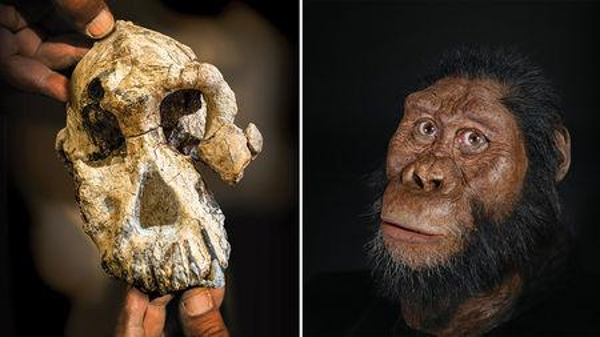Fossil Skull Discovered in Ethiopia Oldest Known Ancestor of Humankind

Image Courtesy: Science. Image is for representational use only.
A 3.8 million years old fossil of a skull has been discovered in Ethiopia. The fossil belongs to an ancient hominin known as Australopithecus anamensis, which is believed to be the direct ancestor of Australopithecus afarensis or the famous “Lucy” species—the very ancient ancestor of modern humans. The discovery is believed to be potential enough to alter our understanding about human evolution.
Lucy has been a celebrated species ever since its discovery in 1974 in Ethiopia. The Lucy fossil consists of several hundred pieces of bone fossils that represent 40% of the skeleton of a female of Australopithecus afarensis. But her direct predecessor has very unclear trace of record with only a handful of teeth, some limb bones and some few fragments of skull—all that there was for clues about appearance and lifestyle. The latest fossil is remarkable as it is a complete male skull and has now been named as MRD, after the place Miro Dora, where it has been found.
The period of history that the Lucy species were roaming in the lands of Africa, was the period when our ancestors emerged from the trees and began to walk on two legs. But they had distinctly ape-like protruding faces with powerful jaws and small brains. And they were the very early ancestor of humans.
Analysis of MRD reveals that it had a small brain, which, approximately is about quarter of the size of a modern human. The analysis also revealed that the species was losing some of its ape like features. Its canines are smaller than could be observed in the earlier fossils and also it was developing powerful jaws with prominent cheekbones which were also seen in Lucy. Scientists think these developments helped the species chew tough food during the period of dryness and less vegetation.
The most interesting fact that emerged out of the dating of MRD is that anamensis and its descendent Lucy, coexisted for a period of at least 100,000 years. This discovery challenges the long standing notion of linear evolution—one species gradually disappears and a new one takes the place of the earlier one. The anamensis existed in the world, precisely in Africa within a span of 4.2 to 3.8 million years ago. "We used to think that A. anamensis gradually turned into A. afarensis over time. We still think that these two species had an ancestor-descendent relationship, but this new discovery suggests that the two species were actually living together in the Afar for quite some time. It changes our understanding of the evolutionary process and brings up new questions -- were these animals competing for food or space?”—explains Stephanie Melillo, the corresponding author of the research paper published in Nature. Anamensis is still thought to be Lucy’s ancestor.
Afarensis has often been put forward as the likely ancestor that ultimately gave rise to the Homo lineage, which the modern human belong to. But the new discovery which hints that multiple different lineages coexisted brings this hypothesis under question. “Having multiple candidate ancestral species in the right time and place makes it more challenging to determine which gave rise to Homo,” said Melillo.
MRD was found in February 2016 in the Afar region in Northeastern Ethiopia, just 55 kilometres away from the site where the Lucy fossil was found. The entire analysis and the inferences took 3 long years. The study involved two groups from two different institutes—one from the Max Planck Institute for Evolutionary Anthropology, Germany and the other Cleveland Museum of Natural History, USA.
Get the latest reports & analysis with people's perspective on Protests, movements & deep analytical videos, discussions of the current affairs in your Telegram app. Subscribe to NewsClick's Telegram channel & get Real-Time updates on stories, as they get published on our website.














